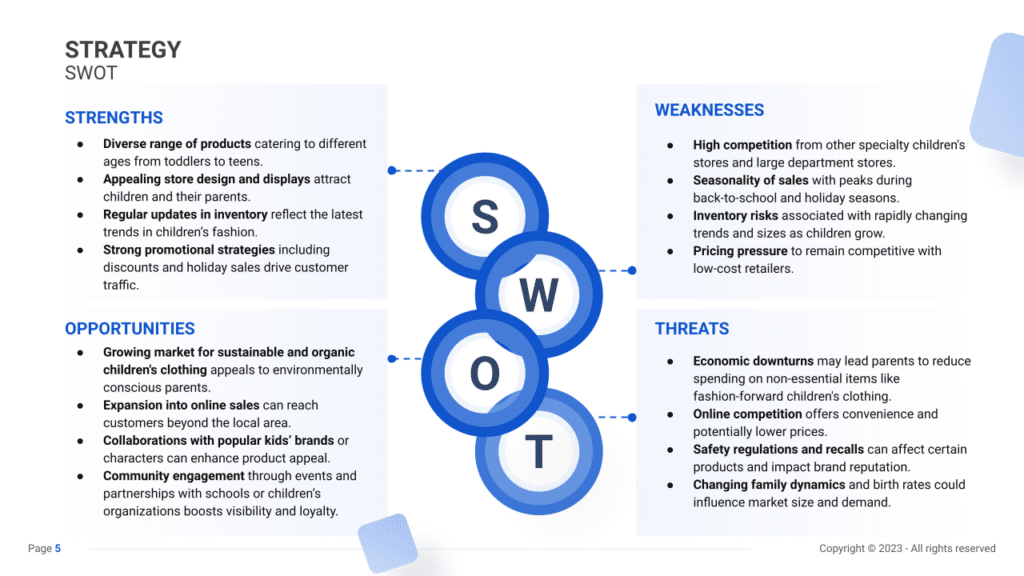SWOT Analysis for a Kid’s Clothing Store (Example)

A SWOT analysis is crucial for developing a business plan for a kid’s clothing store. This analysis, which stands for Strengths, Weaknesses, Opportunities, and Threats, helps understand internal and external factors that can impact your business. Strengths and weaknesses are internal to the business, while opportunities and threats are external.
In this article, we will explore various examples of strengths, weaknesses, opportunities, and threats, aiding Kid’s Clothing store owners in incorporating these insights into their business strategies.

Strengths
Highlight the strengths that distinguish your kid’s clothing store and foster customer satisfaction and loyalty.
- Unique Product Selection: Curating a distinctive range of children’s clothing that features trendy designs, eco-friendly materials, or specialty items sets your store apart.
- Example: Showcase unique pieces prominently in displays and marketing campaigns, highlighting their exclusivity and appeal to fashion-conscious parents.
- Engaging Store Environment: Creating an interactive and child-friendly shopping ambiance enhances the overall customer experience, encouraging longer visits and repeat patronage.
- Example: Develop dedicated play areas or interactive displays within the store, fostering a welcoming atmosphere for families and ensuring a memorable shopping experience.
- Robust Online Presence: A well-designed and accessible online platform offering clear product images and seamless purchasing options significantly boosts sales and market reach.
- Example: Leverage social media channels to showcase products, share parenting tips, and conduct online promotions, enhancing brand visibility and attracting a wider audience.
- Customer Loyalty Programs: Implementing loyalty programs or membership rewards for frequent shoppers cultivates a loyal customer base and encourages repeat visits.
- Example: Offer exclusive discounts, early access to new collections, or birthday rewards to incentivize customer loyalty and retention.
Weaknesses
Address weaknesses to fortify your kid’s clothing store for sustained success.
- Seasonal Dependence: Relying heavily on seasonal fashion trends may lead to inventory challenges and fluctuations in sales.
- Example: Strategically diversify inventory with timeless staples alongside trend-based items to mitigate seasonal variations and manage stock levels effectively.
- Limited Size or Style Range: Constraints in available sizes or limited style options might alienate customers seeking specific clothing types or sizes.
- Example: Expand partnerships with diverse brands or widen size ranges to cater to a broader demographic, ensuring inclusivity in product offerings.
- High Inventory Turnover: Rapidly changing children’s fashion trends can result in excess inventory or obsolete stock.
- Example: Implement efficient inventory management systems and clearance strategies to handle excess stock effectively and maintain a fresh product range.
- Supplier Dependency: Reliance on a few suppliers might pose challenges during supplier shortages or quality inconsistencies.
- Example: Diversify supplier partnerships and negotiate flexible contracts to ensure consistent and varied sourcing options.
Opportunities
Seize opportunities to enhance and expand your kid’s clothing store’s market presence.
- E-commerce Expansion: Expanding the online footprint or implementing an e-commerce platform enables reaching a broader customer base beyond the local market.
- Example: Invest in a user-friendly online store and offer nationwide shipping options to access a wider audience and facilitate convenient shopping experiences.
- Collaborations and Partnerships: Partnering with complementary businesses (e.g., toy stores and childcare centers) for joint promotions or events can amplify visibility and sales.
- Example: Collaborate with local family-oriented businesses for mutually beneficial promotions or organize family-themed events to attract more customers.
- Sustainability Trends: Responding to the increasing demand for sustainable and ethically sourced children’s clothing can attract environmentally conscious consumers.
- Example: Introduce a line of eco-friendly kids’ clothing or highlight existing sustainable options to cater to a growing segment of environmentally aware customers.
- Customization and Personalization: Offering personalized clothing or customizable options can be a unique selling point.
- Example: Introduce personalized embroidery or custom-designed clothing options, catering to parents seeking distinctive items for their children.
Threats
Prepare for potential threats to ensure the resilience of your kid’s clothing store.
- Competitive Landscape: Increased competition from established brands or online retailers offering similar products might impact market share.
- Example: Emphasize personalized customer service, unique offerings, or exclusive in-store experiences to differentiate from larger competitors.
- Economic Uncertainty: Economic downturns or fluctuations can affect consumer spending on non-essential items like children’s clothing.
- Example: Implement flexible pricing strategies, offer discounts during economic downturns, or introduce loyalty rewards to maintain customer retention in challenging economic times.
- Shifting Consumer Preferences: Rapid changes in fashion trends or consumer preferences can lead to mismatches in inventory and customer demands.
- Example: Stay updated with fashion forecasts, conduct customer surveys, and analyze sales data to adapt inventory according to evolving market demands.
- Logistical Challenges: Supply chain disruptions, shipping delays, or logistical issues can impact inventory availability and timely deliveries.
- Example: Maintain strong supplier relationships, establish backup plans for logistics, and communicate transparently with customers about potential delays to mitigate issues.





